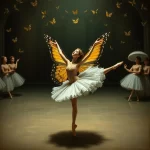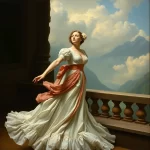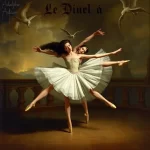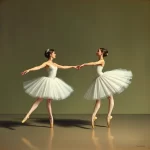Ballet: Le Papillon (Jacques Offenbach, 1860)

Introduction
Ballet, a classical dance form known for its grace and precision, has produced numerous masterpieces over the centuries. One such gem is “Le Papillon,” a ballet composed by Jacques Offenbach in 1860. Choreographed by Marie Taglioni, this ballet premiered on November 26, 1860, at the Paris Opera. “Le Papillon” tells a whimsical and enchanting story of transformation, love, and magic, capturing the imaginations of audiences with its ethereal themes and captivating performances.
Historical Background
Creation and Development
“Le Papillon” was created during a period of significant artistic and social change in Europe. The mid-19th century was marked by a fascination with romanticism, which emphasized emotion, nature, and the supernatural. This cultural backdrop influenced the creation of “Le Papillon,” which draws inspiration from fairy tales and folklore. The ballet’s story is loosely based on themes of metamorphosis and enchantment, common motifs in romantic literature.
The collaboration between Jacques Offenbach, a renowned composer known for his operettas, and Marie Taglioni, a pioneering ballerina and choreographer, was instrumental in bringing “Le Papillon” to life. Taglioni’s innovative choreography and Offenbach’s melodic compositions combined to create a ballet that was both visually and musically enchanting.
Premiere and Reception
“Le Papillon” premiered on November 26, 1860, at the Paris Opera. The initial reception was mixed, with some critics praising the ballet’s imaginative storyline and beautiful music, while others were less enthusiastic about its departure from traditional ballet themes. Despite the varied critical response, the ballet quickly gained popularity among audiences, leading to numerous performances and revivals in the years that followed.
Synopsis of the Ballet
Act I Summary
The ballet opens with the introduction of the main characters: Farfalla, a young girl who is transformed into a butterfly by a fairy, and Prince Djalma, who falls in love with her. The fairy, who is both mischievous and benevolent, sets the stage for the magical events that follow. Farfalla’s transformation into a butterfly is a key moment in Act I, symbolizing the themes of change and enchantment that run throughout the ballet.
Act II Summary
In Act II, Farfalla, now a butterfly, navigates the challenges and wonders of her new form. She encounters various characters, including other enchanted creatures and magical beings. Prince Djalma continues his quest to find and rescue Farfalla, leading to a series of adventures and trials. The act is filled with vibrant dances and intricate choreography, showcasing the talents of the performers.
Finale
The ballet concludes with a dramatic and emotional finale. Prince Djalma finally finds Farfalla and, with the help of the fairy, breaks the enchantment. Farfalla is transformed back into her human form, and the two lovers are reunited. The ballet ends on a joyous note, celebrating the triumph of love and the power of magic.
Musical Composition
Composer’s Role
Jacques Offenbach, a prolific composer known for his operettas, brought his unique musical style to “Le Papillon.” His compositions for the ballet are characterized by their melodic richness and rhythmic vitality. Offenbach’s music plays a crucial role in conveying the emotions and themes of the ballet, enhancing the narrative through its expressive power.
Musical Themes and Motifs
The score of “Le Papillon” features several recurring musical themes and motifs that reflect the characters and their journeys. For example, Farfalla’s transformation is accompanied by a delicate and fluttering motif, while Prince Djalma’s quest is underscored by a more heroic and determined theme. These musical elements help to create a cohesive and immersive experience for the audience.
Famous Recordings and Performances
Over the years, “Le Papillon” has been performed by numerous ballet companies and orchestras. Notable recordings of the ballet’s music include performances by the Paris Opera Orchestra and the Royal Ballet Sinfonia. These recordings capture the beauty and intricacy of Offenbach’s compositions, allowing listeners to appreciate the ballet’s musical richness even outside the theater.
Choreography and Dance
Choreographer’s Vision
Marie Taglioni, one of the most influential ballerinas of the 19th century, brought her visionary approach to the choreography of “Le Papillon.” Taglioni’s style was characterized by its emphasis on lightness and ethereal movement, qualities that perfectly suited the ballet’s themes of transformation and magic. Her innovative choreography set new standards for ballet performance and continues to inspire dancers today.
Signature Dance Numbers
“Le Papillon” features several signature dance numbers that highlight the talents of the performers and the creativity of the choreography. One of the most memorable scenes is the Pas de Deux between Farfalla and Prince Djalma, a romantic and technically demanding dance that showcases the chemistry between the lead dancers. Other notable numbers include the fairy’s solo dance and the ensemble pieces featuring the enchanted creatures.
Notable Interpretations
Over the years, different productions of “Le Papillon” have brought their own interpretations to the choreography. Some have emphasized the ballet’s romantic elements, while others have focused on its magical and fantastical aspects. These variations reflect the versatility of Taglioni’s choreography and the enduring appeal of the ballet.
Characters and Roles
Main Characters
- Farfalla: The protagonist of the ballet, Farfalla is a young girl who is transformed into a butterfly by a fairy. Her journey of transformation and love is central to the story.
- Prince Djalma: The hero of the ballet, Prince Djalma falls in love with Farfalla and embarks on a quest to rescue her from her enchanted form.
- The Fairy: A magical being who transforms Farfalla into a butterfly. The fairy’s actions drive the plot and add an element of enchantment to the story.
Supporting Characters
- Enchanted Creatures: Various magical beings who interact with Farfalla and Prince Djalma throughout the ballet.
- Courtiers and Villagers: Secondary characters who add depth to the story and participate in the ensemble dances.
Famous Dancers
Several renowned dancers have portrayed the roles in “Le Papillon” over the years. Notable performers include Marie Taglioni herself, who originated the role of Farfalla, and later dancers such as Margot Fonteyn and Rudolf Nureyev, who brought their own interpretations to the lead roles.
Cultural and Artistic Impact
Influence on Ballet and Dance
“Le Papillon” has had a lasting impact on the world of ballet and dance. Its innovative choreography and enchanting story have inspired countless other works and choreographers. The ballet’s emphasis on transformation and magic has also influenced the development of narrative ballet, paving the way for future productions that explore similar themes.
Cultural Significance
The ballet’s themes of love, transformation, and enchantment have resonated with audiences for over a century. “Le Papillon” has been referenced in literature, film, and other media, cementing its place in popular culture. Its enduring appeal speaks to the universal nature of its story and the timeless beauty of its music and choreography.
Legacy and Revivals
“Le Papillon” continues to be performed and celebrated today. Major revivals and reinterpretations have brought the ballet to new audiences, ensuring its place in the repertoire of ballet companies around the world. Modern adaptations have also explored new ways to present the story, incorporating contemporary elements while staying true to the original vision.
Iconic Productions
Historic Productions
Some of the most famous historical productions of “Le Papillon” include its original run at the Paris Opera and subsequent performances by renowned ballet companies such as the Bolshoi Ballet and the Royal Ballet. These productions featured key figures in the world of dance, including legendary dancers, directors, and set designers.
Contemporary Productions
Recent productions of “Le Papillon” have brought fresh perspectives to the ballet. Contemporary choreographers have reimagined the story and choreography, incorporating modern techniques and interpretations. These productions highlight the ballet’s enduring relevance and its ability to captivate new generations of audiences.
Production Design
The set, costume, and lighting design in various productions of “Le Papillon” have played a crucial role in bringing the magical world of the ballet to life. From elaborate fairy-tale settings to innovative lighting effects, the production design has enhanced the visual and emotional impact of the performances.
Critical Reception and Reviews
Initial Critical Response
At the time of its premiere, “Le Papillon” received mixed reviews from critics. While some praised the ballet’s imaginative storyline and beautiful music, others were less enthusiastic about its departure from traditional ballet themes. Despite this, the ballet quickly gained popularity among audiences, leading to numerous performances and revivals.
Modern Reviews
Contemporary critics and audiences continue to appreciate “Le Papillon” for its enchanting story, beautiful music, and innovative choreography. The ballet’s themes of transformation and love resonate with modern viewers, and its artistic achievements are recognized as significant contributions to the world of dance.
Fun Facts and Trivia
Behind-the-Scenes Stories
One interesting anecdote from the production of “Le Papillon” involves Marie Taglioni’s dedication to her role as choreographer. It is said that she spent countless hours perfecting the choreography and working with the dancers to ensure that every movement captured the ballet’s ethereal quality.
Notable Performers
Over the years, many famous dancers have been associated with “Le Papillon.” In addition to Marie Taglioni, other notable performers include Margot Fonteyn, Rudolf Nureyev, and more recently, dancers from leading ballet companies around the world.
Trivia
- “Le Papillon” was one of the first ballets to feature a transformation scene, a concept that has since become a staple in many other ballets.
- The ballet’s title, “Le Papillon,” means “The Butterfly” in French, reflecting its central theme of transformation.
- Jacques Offenbach, known primarily for his operettas, composed the music for “Le Papillon” as one of his few ventures into ballet composition.
Conclusion
Summary of the Ballet’s Importance
“Le Papillon” holds a significant place in the world of ballet for its innovative choreography, enchanting story, and beautiful music. The collaboration between Jacques Offenbach and Marie Taglioni resulted in a ballet that continues to captivate audiences with its themes of transformation and love.
Final Thoughts
Reflecting on “Le Papillon,” it is clear that this ballet has left an indelible mark on the art form. Its enduring appeal and influence on subsequent works highlight its importance in the history of dance. For those who have not yet experienced “Le Papillon,” watching a performance or listening to its score is highly recommended to appreciate its timeless beauty and artistic achievements.
FAQ
What is the central theme of this ballet?
The central theme of “Le Papillon” is transformation, both physical and emotional, as well as the power of love and magic.
Who are the main characters in this ballet?
The main characters are Farfalla, a young girl transformed into a butterfly; Prince Djalma, who falls in love with her; and the Fairy, who initiates the transformation.
What is the most famous dance number in this ballet?
One of the most famous dance numbers is the Pas de Deux between Farfalla and Prince Djalma, known for its romantic and technically demanding choreography.
How long does a typical performance of this ballet last?
A typical performance of “Le Papillon” lasts approximately 1.5 to 2 hours, including intermissions.
Are there any modern adaptations of this ballet?
Yes, there have been several modern adaptations of “Le Papillon,” with contemporary choreographers bringing new interpretations to the story and choreography.
Why is this ballet considered important in the history of dance?
“Le Papillon” is considered important for its innovative choreography by Marie Taglioni, its beautiful music by Jacques Offenbach, and its enduring themes of transformation and love that continue to resonate with audiences today.





